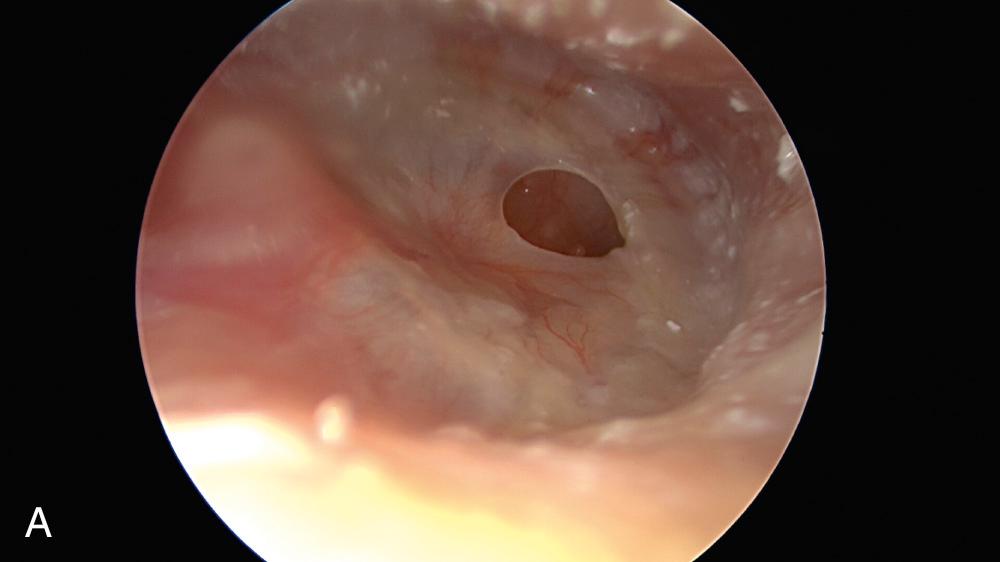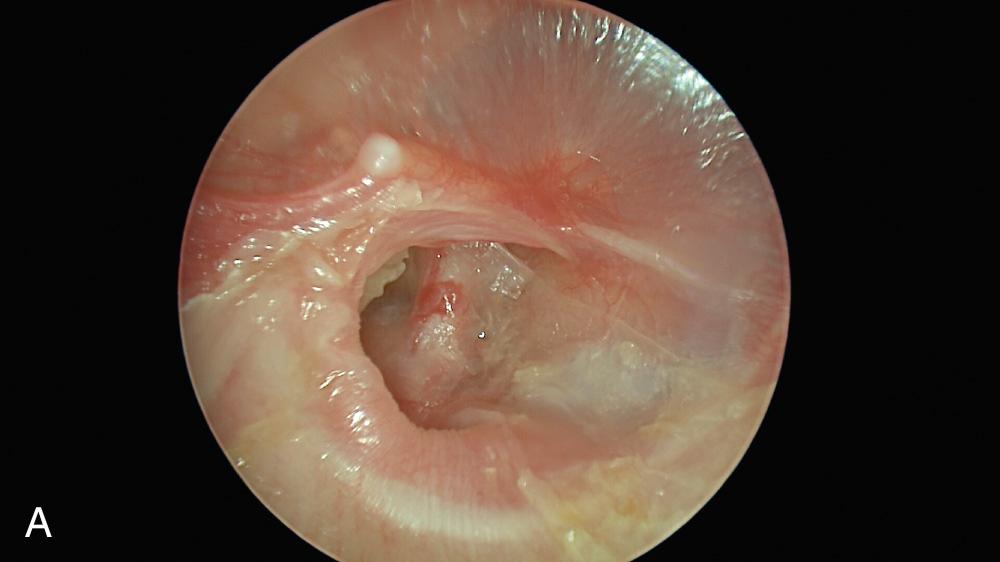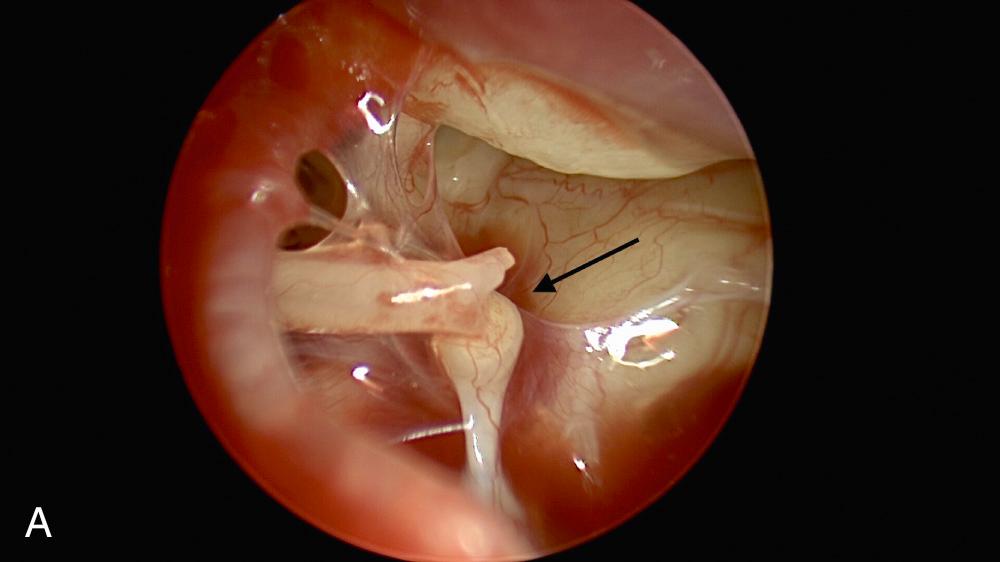Physical Address
304 North Cardinal St.
Dorchester Center, MA 02124
Impedance matching of sound pressure delivered to the inner ear through the auditory conductive pathway results from the interaction of the catenary, ossicular, and hydraulic lever systems housed in the middle ear.
Sound amplification from the middle ear impedance-matching system is 35 dB. The pinna and external auditory canal can add up to an additional 15 dB of amplification, depending on the azimuth of sound delivery.
Radiologic imaging is rarely necessary for preoperative planning in cases of conductive hearing loss.
Conductive hearing loss in the presence of normal acoustic reflexes and elevated bone thresholds should prompt radiologic investigation for a “third window” phenomenon.
Optimized tension from the ossicular reconstruction creates implant stability without unduly loading the annular ligament at the stapes footplate.
Osseointegrated hearing devices are effective in treating conductive hearing loss by bypassing the damaged middle ear system.
Tuning fork testing is an effective method to screen for hearing loss, determine conductive versus sensorineural loss, and validate findings on audiograms.
This chapter summarizes fundamental physical properties of the conductive portion of the auditory system, outlines an appropriate diagnostic evaluation, and proposes a framework for planning surgical treatment of external auditory canal and middle ear defects.
Sound is defined as vibratory energy produced by an object that possesses both inertia and elasticity. The slightest limitation of movement of the tympanic membrane (TM) and ossicular chain, therefore, can manifest as significant compromise of sound conduction.
The acoustic resistance to the passage of sound through a medium is termed impedance . The transduction of vibratory energy from the air in the external auditory canal (EAC) (low impedance) to the cochlear fluids (high impedance) is possible as a result of the impedance-matching function of the middle ear.
The pinnae gather sound from an arc of 135 degrees relative to the direction of the head, and increase sound pressure by 6 dB. The EAC is a closed cylinder roughly 2.5 to 3.5 cm in length. Because ear canal resonance occurs at the frequency whose wavelength is four times the canal length, the corresponding resonant frequency is roughly 3500 Hz. The addition of the conchal component of the pinna increases the EAC length and results in a lower resonant frequency of approximately 2700 Hz. The overall increase in sound pressure transduction caused by external ear structures and measured at the TM is estimated at 15 to 22 dB.
In 1868, Hermann von Helmholtz defined the principles of impedance matching by the middle ear. He proposed three levers to accomplish the required pressure transformation. The TM, which is rigidly fixed at the periphery and mobile centrally, acts as a catenary lever to produce a twofold gain in sound pressure level at the malleus handle in response to pressure changes transmitted through the EAC. Although the thin pars flaccida allows some free movement of the malleus head in the epitympanum and may appear to attenuate middle ear/external ear atmospheric pressure differences, it has only a minor acoustic role in humans. The ossicular lever is produced when the incus and the malleus rotate as a unit around an axis that extends from the anterior mallear ligament through the incudal ligament. The role of the superior mallear ligament in ossicular vibration is unclear. Taken alone, the ossicular lever produces a small mechanical advantage, but further studies by Tonndorf and Khanna showed the catenary lever to be tightly coupled to the ossicular lever because the TM is extensively adherent to the malleus handle. Corrected calculations revealed a combined catenary and ossicular lever ratio of 2.3 : 1. According to studies done on fresh cadaveric human temporal bones, the mean sound-pressure gain produced by the human middle ear is 26.6 dB and is centered around its resonant frequency (0.9 to 1.0 kHz). Above 1 kHz, the pressure gain measured at the stapes footplate decreases at a rate of −8.6 dB per octave. The hydraulic lever facilitates the transduction of sound pressure collected over the larger TM into the piston-like movement below 1 kHz and the rocking movement above 1 kHz of the much smaller stapes footplate, as elegantly described by Guinan and Peake. The resulting mechanical advantage is proportional to the ratio of the TM surface area, about 85 mm, to that of the stapes footplate, about 3.2 mm. After studying 43 human temporal bones, Saunders reported that this “areal ratio” averaged 20.8 : 1 and was the most important component of the middle ear impedance-matching system.
In summary, the increased gain in sound-pressure level from the impedance-matching system of the middle ear and TM measures roughly 34 dB. The EAC and auricle, primarily the conchal component of the pinna, provide an additional increase of up to 15 dB, depending on the azimuth of sound delivery and the functional length of the canal.
In his 1978 review, Austin identified five categories of anatomic defects in the middle ear sound-conducting system and described each within the context of the associated prototypic hearing loss ( Table 145.1 ).
TM perforation with undisturbed ossicular continuity ( Fig. 145.1 ) produced a hearing loss that was linearly proportional to the size of the perforation (loss of areal ratio plus loss of catenary lever) (see Fig. 145.1B ). The degree of hearing loss, flat across speech frequencies, was not altered by the location of the perforation on the drumhead.

TM perforation combined with ossicular disruption ( Fig. 145.2 ) occurred in approximately 60% of Austin's patients and was the most common form of conductive hearing loss (see Fig. 145.2B ) requiring surgical therapy. Incudostapedial joint erosion was the most frequent ossicular anomaly ( Fig. 145.3 ). Incus-to-stapes discontinuity resulted in impedance variation at the oval window. An audiogram may falsely show depressed bone-conducted hearing levels of up to 10 dB in speech frequencies (see Fig. 145.3B ). The magnitude of the conductive loss in these patients was frequently underestimated. Correction of the ossicular problem typically increased bone levels, reflecting the reestablishment of impedance matching at the oval window. Perforation size and the condition of the stapes footplate accounted for variations in this patient group.


Total loss of the TM and ossicles created a condition wherein sound pressure contacted the oval and round windows simultaneously, resulting in partial phase cancelation of the sound wave in the cochlear perilymph. Conductive hearing loss was flat across speech frequencies and averaged 50 dB when corrected for misleading bone levels. More complete phase cancelation caused increased hearing loss as compared with patients who had only partial perforations.
Ossicular disruption behind an intact TM resulted in a maximal conductive hearing loss of 55 to 60 dB. In the absence of functional impedance matching, the intact eardrum reflected sound energy back into the EAC, which caused an additional 17-dB conductive loss above what was expected from removal of the hydraulic and catenary/ossicular lever action. The decreased sound pressure also reached the round and oval windows almost simultaneously and induced phase cancelation in the labyrinthine fluids.
Congenital malformations with ossicular disruption and closure of the oval/round result and in cases with obliterative otosclerosis resulted in a flat loss of 60 dB.
| Classification | Component Disrupted | Expected Loss |
|---|---|---|
| Perforation of tympanic membrane | Loss of areal ratio, catenary lever | Proportional to size of perforation |
| Perforation of tympanic membrane with ossicular interruption | Hydraulic lever, areal ratio, catenary lever | 38.3 dB |
| Total loss of tympanic membrane and ossicular chain | Hydraulic lever, areal ratio, catenary lever, phase cancelation | 50 dB |
| Ossicular interruption with an intact tympanic membrane | Hydraulic lever, areal ratio, catenary lever, phase cancelation, reflection of sound energy away from the middle ear at the tympanic membrane | 55–60 dB |
| Ossicular interruption with an intact tympanic membrane and closure of the oval window (distinct congenital malformation) | Hydraulic lever, areal ratio, catenary lever, phase cancelation, reflection of sound energy away from the middle ear at the tympanic membrane | 55–60 dB |
The use of advanced audiometric testing, laboratory studies or diagnostic imaging is rarely indicated in patients with isolated conductive hearing loss. Complete assessment of a patient with hearing loss begins with a careful history. A thorough head and neck examination, cranial nerve testing, and otoscopy are mandatory ( Box 145.1 ). Otomicroscopy to remove foreign bodies, examine the TM, and assess middle ear structures more precisely is a prudent step in preoperative evaluation.
Age at onset
Abrupt versus gradual
Progressive, intermittent, or continuous
Antecedent illness
Duration of symptoms
Become a Clinical Tree membership for Full access and enjoy Unlimited articles
If you are a member. Log in here